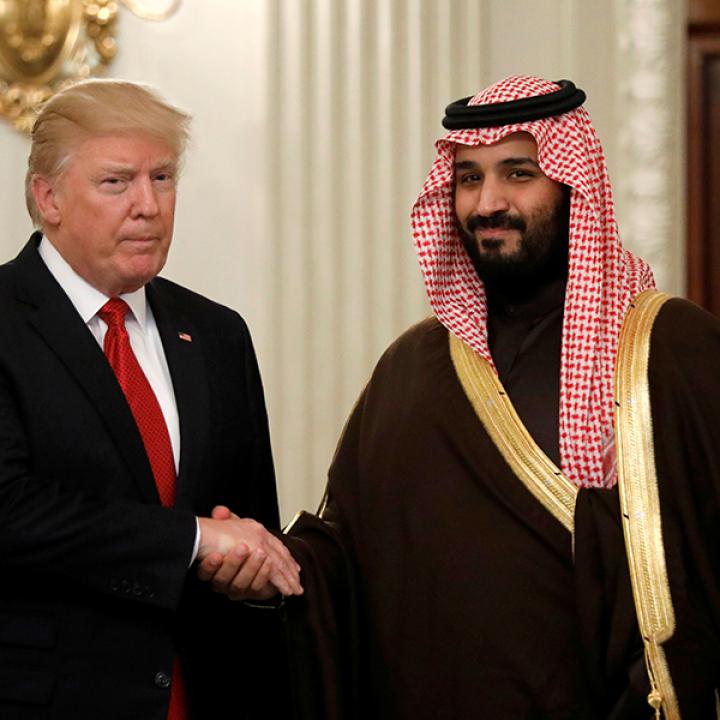
- Policy Analysis
- Policy Alert
What a U.S.-Saudi Nuclear “Pathway” Might Mean for the Iran Talks

Rather than clearing a route to normalization with Israel, a Saudi nuclear agreement with Washington may be key to addressing Iran’s military nuclear potential and wider proliferation concerns in the region.
While visiting Saudi Arabia on April 13—a trip regarded in part as preparation for President Trump’s planned mid-May tour of the Gulf region—U.S. energy secretary Chris Wright announced a preliminary agreement to cooperate on developing the kingdom’s civil nuclear industry. He noted that the two countries were on “a pathway” to such a deal and that further details would come “later in the year.”
Apparently concerned about the potential risk of Saudi nuclear proliferation, Wright also stated, “There will definitely be a 123 agreement.” This was a reference to the eponymous section of the 1954 U.S. Atomic Energy Act, which mandates that formal proliferation safeguards must be put in place before American agencies or companies can help a country start up a civil nuclear industry. The “gold standard” version of a 123 agreement explicitly prohibits enriching or reprocessing nuclear material—a limitation that only the United Arab Emirates and Taiwan have accepted in the past. Countries must instead agree to import reactor fuel rather than producing it themselves, and allow international inspections as well.
Coming on the same weekend that U.S. and Iranian negotiators met in Oman to defuse tensions over Tehran’s nuclear program, Wright’s words were presumably an ingredient in Washington’s wider diplomacy. Pairing the issues would not be surprising—Tehran is enriching uranium to a degree far in excess of what is required for a civil nuclear program, and U.S. officials no doubt recall Saudi crown prince Muhammad bin Salman’s 2018 warning that “if Iran developed a nuclear bomb, we will follow suit as soon as possible.” The kingdom is believed to have at least a nascent enrichment program, ironically relying on the same centrifuge technology supplied to Iran by the late Pakistani scientist A. Q. Khan before he retired in 2001.
Moreover, American nuclear technology was reportedly a Saudi “ask” during past discussions about normalizing relations with Israel, in addition to U.S. security guarantees and access to top-shelf military equipment and technology. Yet this political package has been delayed since 2023 by the Gaza war.
Going forward, progress on a U.S.-Saudi “pathway” will have its own challenges apart from the fighting in Gaza and negotiations with Iran. Although American nuclear technology is still widespread, the United States is no longer active in selling civil nuclear power plants, and its main domestic centrifuge plant is operated by a European consortium. Notably, U.S. engineers are developing small modular reactors (SMRs), an advanced new technology that could be useful for desalination and power generation in the Middle East. Yet the first wave of American SMRs is still under licensing review and is not expected to be deployable until at least “the late 2020s to early 2030s.” Currently, the world’s only operational SMRs are in Russia and China.
U.S. officials are aware that Saudi Arabia may insist on retaining its right to enrich if it signs a 123 agreement. When Washington signed a 123 with the United Arab Emirates in 2009 and approved the country’s purchase of South Korean reactors containing U.S. technology, it appeared to accept a decades-old provision that Abu Dhabi could enrich uranium if any other countries in the region are granted that right: “The fields of cooperation, terms and conditions accorded...shall be no less favorable in scope and effect than those which may be accorded from time to time to any other non-nuclear weapons state in the Middle East in a peaceful nuclear cooperation agreement.” Theoretically, a country could also just withdraw from a 123 deal once it has obtained substantial U.S. technology and assistance.
For now, the next step in Washington’s regional nuclear diplomacy is another round of talks between U.S. envoy Steve Witkoff and Iran, expected to begin on April 19. Yet the Trump administration’s recent public statements about its negotiating position have seemed contradictory. On April 15, Witkoff tweeted that “Iran must stop and eliminate its nuclear enrichment and weaponization program.” The day before, however, he indicated that the United States was looking to limit the enrichment program rather than dismantle it, telling Fox News, “They do not need to enrich past 3.67 percent...This is going to be much about verification on the enrichment program and then ultimately verification on weaponization.”
Whatever the case, as long as talks continue, U.S. support for any Israeli military action against Iran is essentially suspended. Washington’s Gulf Arab allies have engaged more with Tehran in recent months and appear reluctant to support military strikes against the nuclear program. Despite skepticism about the diplomatic path, last weekend’s developments in Riyadh and Muscat may signal progress on reducing Iran’s nuclear threat to the region—albeit at the potential cost of keeping Saudi Arabia’s close relations with Israel unofficial for the time being. President Trump’s forthcoming Gulf tour will likely concentrate on business and trade relations; he will not want it disrupted by lingering nuclear differences.
Simon Henderson is the Baker Senior Fellow at The Washington Institute and director of its Bernstein Program on Gulf and Energy Policy.



